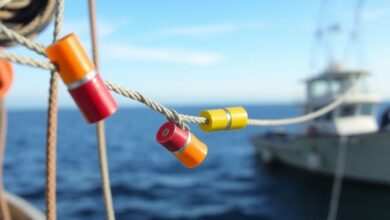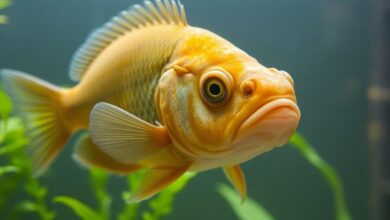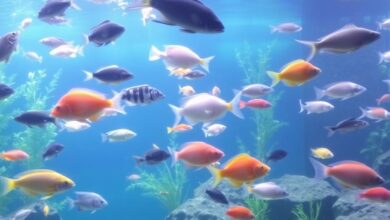The Candy Cane Angelfish is a beautiful and unique fish that can make a wonderful addition to your aquarium. Known for its vibrant colors and interesting behaviors, this species is not only visually striking but also relatively easy to care for. In this article, we will explore essential care tips, unique features, and everything you need to know to keep your Candy Cane Angelfish happy and healthy.
Key Takeaways
- Candy Cane Angelfish thrive in well-planted tanks with plenty of hiding spots.
- They prefer warmer water temperatures between 78-86°F.
- A balanced diet of flakes, pellets, and live food is crucial for their health.
- Regular water changes help maintain good water quality and prevent diseases.
- They are peaceful fish that do well with other non-aggressive species.
Understanding the Candy Cane Angelfish

Origins and Natural Habitat
The Candy Cane Angelfish is a stunning species that originates from the warm waters of the South Pacific. They thrive in coral reefs and lagoons, where they find plenty of hiding spots among the rocks and corals. This fish is often found in schools, which helps them feel safe and secure in their environment.
Physical Characteristics
Candy Cane Angelfish are known for their vibrant colors and unique patterns. They typically have:
- Bright orange and white stripes that resemble a candy cane.
- A body length that can reach up to 6 inches.
- Long, flowing fins that add to their graceful appearance.
| Feature | Description |
|---|---|
| Max Size | Up to 6 inches |
| Color | Orange and white stripes |
| Lifespan | 10-15 years in captivity |
Behavioral Traits
These fish are generally peaceful but can be territorial, especially during breeding. They enjoy swimming in open water but also appreciate places to hide. Here are some key behavioral traits:
- Social creatures that prefer to be in groups.
- Can exhibit aggressive behavior towards similar species.
- Often engage in playful interactions with tank mates.
Candy Cane Angelfish are not just beautiful; they also have unique personalities that make them a joy to keep in an aquarium. Their vibrant colors and playful nature can brighten up any tank!
Setting Up the Perfect Aquarium for Candy Cane Angelfish
Creating a suitable environment for your Candy Cane Angelfish is essential for their health and happiness. Here are some key points to consider:
Tank Size and Requirements
- Minimum tank size: Aim for at least 20 gallons to give your angelfish enough space to swim freely.
- If you plan to keep a small group, consider a 55-gallon tank or larger.
- A deeper tank is ideal since angelfish can grow tall, with fins that may reach over a foot in length.
Water Parameters
- Maintain a water temperature between 76°F and 80°F to mimic their tropical habitat.
- Use a low-flow filter to create gentle water movement, similar to their natural environment.
- Regularly test water for safe levels of nitrate and ammonia using a water test kit.
Aquascaping Tips
- Include tall, soft plants to provide hiding spots and mimic their natural habitat.
- Use smooth decor to prevent snagging their delicate fins. Good choices include java moss and driftwood.
- A finer substrate like sand or smooth gravel is preferred for their comfort.
Compatible Tank Mates
- Angelfish are generally peaceful but can be territorial, especially when breeding.
- Good tank mates include gouramis, plecos, and discus cichlids.
- Avoid fish that nip fins, like barbs, and smaller fish that might be seen as food.
Setting up the right environment may take time, but it’s worth it when you see your Candy Cane Angelfish thrive!
Feeding Your Candy Cane Angelfish

Dietary Needs
Candy Cane Angelfish are omnivores, which means they eat both plant and animal matter. To keep them healthy, provide a varied diet that includes:
- High-quality fish flakes or granules
- Live or frozen foods like brine shrimp, bloodworms, and daphnia
- Algae-based foods for added nutrients
Feeding Schedule
Feed your Candy Cane Angelfish twice a day. It’s best to give them small amounts of food that they can consume in about 2-3 minutes. This helps prevent overfeeding, which can lead to health issues.
Best Types of Food
Here’s a quick table of recommended foods:
| Food Type | Description |
|---|---|
| Fish Flakes | A staple diet for daily feeding |
| Live Foods | Fresh options like brine shrimp |
| Frozen Foods | Convenient and nutritious alternatives |
Remember, variety is key! A mix of different foods will help your Candy Cane Angelfish thrive and stay vibrant.
Health and Wellness of Candy Cane Angelfish
Common Health Issues
Candy Cane Angelfish are generally resilient but can face some health challenges. Common issues include:
- Skin flukes: Look for black or red spots on the skin.
- Ich: This is a parasitic infection that appears as white spots on the fish.
- Dropsy: A serious condition where the fish’s body swells.
Preventative Care
To keep your Candy Cane Angelfish healthy, consider these tips:
- Maintain a clean aquarium environment.
- Ensure a balanced diet with both flakes and live food.
- Regularly check water parameters to avoid stress.
Signs of a Healthy Angelfish
A healthy Candy Cane Angelfish will show:
- Bright and vibrant colors.
- Active swimming behavior.
- No visible signs of disease or distress.
Keeping your fish in a stable environment is crucial. Happy fish are healthy fish, while stress can lead to illness.
Breeding Candy Cane Angelfish
Breeding Conditions
To successfully breed Candy Cane Angelfish, you need to create the right environment. Here are some key points to consider:
- Tank Size: A 20-gallon tank is ideal for breeding. It provides enough space for the fish to swim and lay eggs.
- Temperature: Maintain a water temperature between 75°F and 80°F.
- Lighting: Dim lighting helps create a comfortable atmosphere for breeding.
Spawning Process
The spawning process can be exciting to witness. Here’s how it typically unfolds:
- Pair Selection: Choose a healthy male and female. You can identify them by their size and shape; females tend to be rounder.
- Egg Laying: The female will lay eggs on vertical surfaces like leaves or tank walls. They can lay up to 1,000 eggs at a time!
- Fertilization: The male fertilizes the eggs shortly after they are laid.
Caring for Fry
Once the eggs hatch, the fry need special care:
- Feeding: Start with tiny foods like infusoria or baby brine shrimp.
- Water Changes: Regular water changes are crucial to keep the environment clean.
- Protection: Keep the fry safe from adult fish that might eat them.
Breeding Candy Cane Angelfish can be a rewarding experience, but it requires patience and attention to detail.
By following these guidelines, you can enjoy the process of breeding and raising your own Candy Cane Angelfish!
Unique Features of Candy Cane Angelfish

Distinctive Color Patterns
The Candy Cane Angelfish is known for its vibrant colors. Its body features a striking combination of rosy salmon hues with dark red fins. The dorsal and pelvic fins are tipped with white, adding to its visual appeal. This unique coloration makes it stand out in any aquarium setting.
Behavioral Peculiarities
Candy Cane Angelfish exhibit some interesting behaviors:
- They are generally peaceful and prefer to swim in schools.
- They can become stressed in the presence of larger, aggressive fish.
- They enjoy hiding in plants and caves, which mimics their natural habitat.
Comparison with Other Angelfish Species
When compared to other angelfish, the Candy Cane Angelfish has some unique traits:
| Feature | Candy Cane Angelfish | Other Angelfish Species |
|---|---|---|
| Coloration | Rosy salmon with red fins | Varies widely |
| Size | Up to 3 inches | Up to 12 inches |
| Behavior | Peaceful, shoaling | Can be territorial |
The Candy Cane Angelfish is not just a pretty face; its behavioral traits and adaptability make it a favorite among aquarists. Its unique features contribute to its charm and popularity in the aquarium hobby.
Maintaining Water Quality for Candy Cane Angelfish
Filtration Systems
To keep your Candy Cane Angelfish healthy, clean water is crucial. Here are some tips for effective filtration:
- Use a filter that doesn’t create strong currents, as these fish prefer calm waters.
- Consider a sponge filter for gentle filtration.
- Regularly clean the filter to ensure it works efficiently.
Regular Water Changes
Changing the water in your aquarium is essential. Aim for:
- 30-50% water change every two weeks.
- Use a siphon to remove debris from the substrate.
- Always treat tap water with a dechlorinator before adding it to the tank.
Monitoring Water Parameters
Keeping an eye on water conditions is vital for your fish’s health. Here’s what to check:
- Temperature: Maintain between 76°F to 80°F.
- pH Level: Keep it between 6.6 to 7.8.
- Hardness: Aim for 3–12 dGH.
Regular monitoring helps prevent sudden changes that can stress your fish. Monitor water temperature to suit your fish species’ needs. Sudden changes in temperature can stress fish and make them more susceptible to disease.
By following these guidelines, you can create a safe and comfortable environment for your Candy Cane Angelfish, ensuring they thrive in your aquarium.
Final Thoughts on Candy Cane Angelfish Care
In conclusion, caring for Candy Cane Angelfish can be a rewarding experience for both beginners and seasoned fish keepers. These vibrant fish not only add beauty to your aquarium but also bring a lively spirit to your underwater world. By providing them with a suitable environment, proper diet, and compatible tank mates, you can ensure they thrive. Remember to keep their tank clean and maintain stable water conditions to promote their health and happiness. With the right care, your Candy Cane Angelfish will flourish, making your aquarium a stunning display of color and life.
Frequently Asked Questions
What is the natural habitat of the Candy Cane Angelfish?
Candy Cane Angelfish are usually found in the warm waters of the Amazon River and its tributaries, where they live in groups among plants and rocks.
How big do Candy Cane Angelfish get?
These fish can grow up to about 6 inches long when fully grown.
What do Candy Cane Angelfish eat?
They are omnivores, which means they eat both plant and animal matter. They enjoy a diet of flakes, pellets, and frozen foods.
Can Candy Cane Angelfish live with other fish?
Yes, they are generally peaceful and can live with other non-aggressive fish. Just make sure not to put them with fin-nippers.
How often should I feed my Candy Cane Angelfish?
Feed them once or twice a day, giving them only what they can eat in a few minutes.
What are some signs that my Candy Cane Angelfish is healthy?
A healthy Candy Cane Angelfish will be active, have bright colors, and eat well. Look for clear eyes and no signs of disease.





